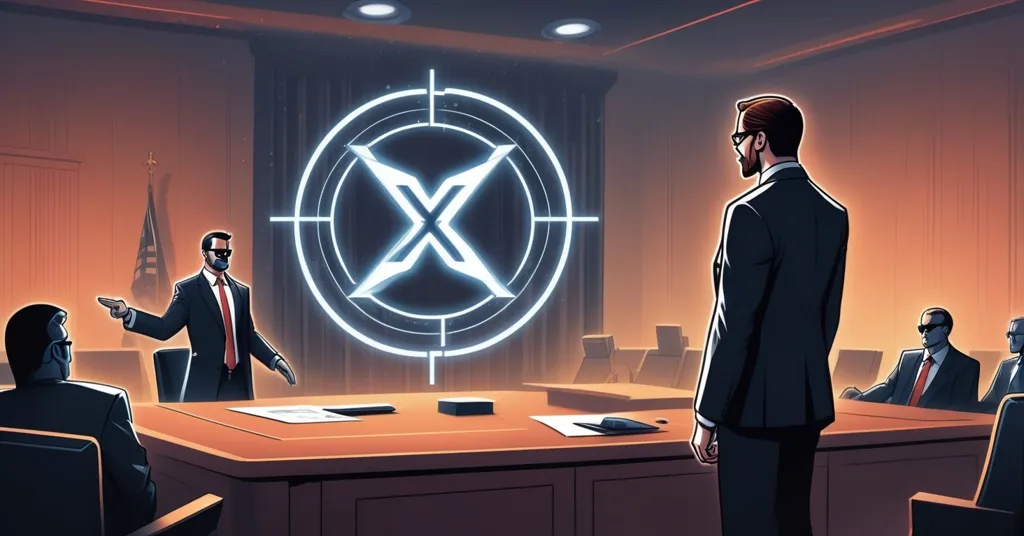Ripple vs. SEC: Will August 2025 End XRP’s Regulatory Battle for Good?

Ripple vs. SEC Showdown: Could August 2025 Finally Free XRP from Regulatory Chains?
The long-running legal clash between Ripple and the U.S. Securities and Exchange Commission (SEC) might be nearing its endgame, with August 2025 looming as a make-or-break moment for XRP. After years of uncertainty casting a shadow over one of crypto’s most polarizing assets, a resolution could unlock regulatory clarity, institutional adoption, and a wave of innovation—or it could be another frustrating delay in a saga that’s tested everyone’s patience.
- Legal Update: Ripple dropped its cross-appeal on June 27, 2025, paying a $125 million penalty to move forward.
- Critical Date: August 15, 2025, is when both parties must submit a status report to the appellate court, possibly ending the battle.
- Potential Fallout: A mutual dismissal could cement XRP as a non-security, spurring ETF filings and unveiling major partnerships.
The Backstory: Why Ripple vs. SEC Matters
This feud kicked off in December 2020 when the SEC slapped Ripple with a lawsuit, claiming that XRP was being sold as an unregistered security, especially in institutional sales. For those new to the game, a “security” is like buying a stake in a company—think stocks—where you expect profits based on their success. The SEC argues Ripple’s XRP sales fit this bill, while Ripple insists XRP is a digital currency or utility token powering the XRP Ledger (XRPL), a decentralized blockchain built for lightning-fast, dirt-cheap cross-border payments. This isn’t just a nerdy legal spat; the outcome could define how the U.S. regulates every cryptocurrency, not just XRP. For a deeper dive into the history and details of this case, check out the comprehensive overview on Ripple Labs’ background.
The stakes have been brutal for Ripple. U.S. exchanges like Coinbase delisted XRP, partnerships stalled, and investor confidence took a nosedive. A partial win came in July 2023 when Judge Analisa Torres ruled that XRP isn’t a security when traded on public exchanges, but institutional sales did violate securities laws. This split decision left both sides itching for more fight, with appeals filed. That is, until Ripple blinked first, withdrawing its cross-appeal on June 27, 2025, under CEO Brad Garlinghouse’s leadership, and parking a hefty $125 million penalty in escrow as a peace offering. Now, eyes are on the SEC to see if it’ll reciprocate—or keep dragging its feet like a bureaucrat on a coffee break.
August 2025: The Turning Point?
Mark your calendars for August 15, 2025. That’s when Ripple and the SEC are due to submit a joint status report to the appellate court, a procedural step that could signal whether both sides are ready to bury the hatchet. Legal heavyweights like former SEC attorney Marc Fagel highlight this as a key moment, suggesting a mutual dismissal might finally wrap things up. Another expert, Bill Morgan, cautions there’s no hard deadline for the SEC to drop its appeal, and they could still request more time—because, let’s face it, regulatory stonewalling is practically their brand. To stay updated on the latest developments, you can follow community discussions on platforms like Reddit for real-time XRP lawsuit updates.
If both appeals vanish, Judge Torres’ ruling stands: XRP isn’t a security on public exchanges. That’s a massive green light for Ripple to operate without the SEC breathing down its neck, at least in the retail market. But if the SEC digs in, we’re looking at more years of limbo, and the frustration in the XRP community—already boiling over on social media—will hit a fever pitch. Will the SEC play nice, or are we in for another round of their trademark nonsense? For insights into what a potential resolution might look like, explore analysis on the Ripple-SEC battle’s possible conclusion.
XRP’s Potential: ETFs, Partnerships, and Payments Revolution
Let’s say the stars align, and the case resolves in Ripple’s favor. The ripple effects—pun intended—could be game-changing. First, regulatory clarity would likely establish XRP as a non-security for public trading, opening the floodgates for U.S. exchange relistings and institutional interest. Market commentator Vincent Van Code is hyping the possibility of up to 1,700 companies, currently bound by non-disclosure agreements (NDAs) with Ripple, stepping out of the shadows to reveal systems or partnerships built on the XRPL. We’re talking cross-border payment solutions, central bank digital currency (CBDC) pilots in places like Palau and Bhutan, and tie-ups with financial giants like Santander and BNY Mellon. For more on these potential partnerships, see predictions about Ripple’s post-lawsuit collaborations. Ripple’s network, RippleNet, already serves over 300 institutions, slashing remittance costs by up to 70% in a $650 billion market. Sending money to family overseas faster than Western Union and cheaper than a latte? That’s the real-world impact we’re looking at.
Then there’s the buzz around Spot XRP ETFs (Exchange-Traded Funds, investment products that track XRP’s price for mainstream investors without them owning the token directly). Analysts predict a wave of filings akin to Bitcoin and Ethereum ETFs if legal hurdles clear. SEC Commissioner Hester Peirce has hinted that delays in ETF reviews aren’t outright rejections, and market data backs the optimism—XRP futures Open Interest recently spiked to a two-year high of $1.8 billion, with a bullish Options Put/Call Ratio of 0.68 showing strong confidence. Analyst Armando Pantoja even throws out wild price targets of $10 to $15 by 2030, though let’s be real—those numbers are pure fantasy until we see hard adoption numbers. For more on how clarity could drive ETF filings, check out insights on XRP’s institutional adoption potential.
Reality Check: Don’t Pop the Champagne Yet
Before we start daydreaming about XRP mooning to double digits, let’s pump the brakes. The SEC’s legendary talent for procrastination could easily push a resolution past August 2025. Whispers of a reduced $50 million penalty instead of the court-ordered $125 million are floating around, but there’s zero confirmation in legal filings—pure speculation. Even if the lawsuit ends, bigger economic storms like inflation or central banks hiking rates could dampen XRP’s appeal as a global bridge currency. And let’s not forget the elephant in the room: XRP’s centralized design. Ripple holds a massive chunk of XRP supply, and critics—especially Bitcoin purists—call it a “banker’s coin” that clashes with the ethos of decentralization. Legal clarity won’t erase that stigma overnight. To understand how SEC actions influence market dynamics, read up on crypto regulation’s broader impact on XRP.
Competition is another thorn in Ripple’s side. Stellar (XLM), another payment-focused blockchain, offers similar cross-border solutions with less baggage. Ethereum dominates DeFi, Solana boasts speed, and Bitcoin remains the unchallenged store of value. Can XRP carve a unique niche, or has it missed the boat after years of legal drama? And those lofty price predictions? I’ve got a blockchain bridge to sell you if you believe them without seeing institutional uptake first. Hype trains derail fast in crypto, and the XRP community knows that pain better than most after half a decade of waiting. For community perspectives on how this case affects investors, browse discussions on the Ripple-SEC case’s impact.
Beyond XRP: A Test for Crypto’s Future
This isn’t just Ripple’s fight—it’s a litmus test for the entire crypto space. A mutual dismissal of appeals could set a precedent for how tokens are classified, potentially loosening the SEC’s death grip on other projects. Bitcoin and Ethereum already enjoy relative clarity, with ETFs trading and institutional backing growing. If XRP joins that club, it’s a win for altcoins filling niches Bitcoin doesn’t touch, like instant global payments. But if the SEC doubles down, the chilling effect on innovation could linger for years, stifling smaller blockchain projects under a mountain of red tape. Frankly, if they keep treating every token like a security, they might as well start regulating Monopoly money. To get a sense of where things stand as of August 15, 2025, take a look at updates on the Ripple-SEC appellate court status.
From a Bitcoin maximalist lens, XRP will never dethrone BTC as the ultimate decentralized money. Bitcoin’s store-of-value narrative is rock solid, while XRP’s utility in payments is a different beast—potentially complementary, not competitive. Still, Ripple’s corporate sheen rubs some decentralization diehards the wrong way. Legal win or not, can XRP shake the perception of being a suits-in-boardrooms coin, or is it just a wolf in blockchain sheep’s clothing?
Ripple’s track record adds weight to the optimism, though. With over 300 financial institutions on RippleNet and real-world use cases—like Santander using XRPL for transfers in Latin America—there’s proof of concept beyond speculative trading. If regulatory shackles come off, XRP could be a serious player in disrupting global finance, not just another altcoin riding hype waves.
Key Questions and Takeaways for XRP and Beyond
- What’s the latest on the Ripple vs. SEC lawsuit?
Ripple withdrew its cross-appeal on June 27, 2025, and paid a $125 million penalty, while the SEC’s decision to drop its appeal is still pending. A joint status report on August 15, 2025, could mark the end. - Why is August 15, 2025, such a big deal for XRP?
It’s the deadline for Ripple and the SEC to update the appellate court, potentially confirming a mutual dismissal and wrapping up this four-year ordeal. - What could a favorable outcome mean for XRP’s market status?
Clarity would likely establish XRP as a non-security on public exchanges, paving the way for relistings, Spot XRP ETFs, and partnerships with up to 1,700 NDA-bound companies. - Are there still risks even with a legal win?
Absolutely—SEC delays, economic headwinds, XRP’s centralized reputation, and competition from other blockchains could still hinder adoption and growth. - How does Ripple’s $125 million penalty play into this?
Paid as a compliance gesture for past institutional sales violations, it’s meant to settle the issue, though unverified rumors of a reduced $50 million fine persist. - Could this reshape crypto regulation at large?
A resolution might set a framework for token classification, easing SEC pressure on other projects and fostering a friendlier environment for blockchain innovation. - Is XRP a rival or partner to Bitcoin’s dominance?
Unlike Bitcoin’s focus on being digital gold, XRP targets payment utility. A legal win could position it as a complementary force, though its centralized roots might alienate purists.
As we edge closer to August 15, 2025, the Ripple vs. SEC saga feels like a pressure cooker ready to blow—or fizzle out in yet another delay. This isn’t just a date; it’s a potential watershed for XRP, Ripple, and the broader fight for crypto legitimacy. While the promise of ETFs, partnerships, and payments disruption fuels hope, years of SEC-induced whiplash keep expectations in check. Will this finally unshackle XRP to claim its spot in the financial revolution, or are we doomed to more regulatory tug-of-war? Time, and a begrudging SEC, will tell.


